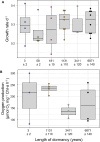Resurrection of a diatom after 7000 years from anoxic Baltic Sea sediment
- PMID: 39749986
- PMCID: PMC11742256
- DOI: 10.1093/ismejo/wrae252
Resurrection of a diatom after 7000 years from anoxic Baltic Sea sediment
Abstract
Dormancy is a widespread key life history trait observed across the tree of life. Many plankton species form dormant cell stages that accumulate in aquatic sediments and, under anoxic conditions, form chronological records of past species and population dynamics under changing environmental conditions. Here we report on the germination of a microscopic alga, the abundant marine diatom Skeletonema marinoi Sarno et Zigone, that had remained dormant for up to 6871 ± 140 years in anoxic sediments of the Baltic Sea and resumed growth when exposed to oxygen and light. Resurrected diatom strains, representing cohorts from six different time points of the past 6871 ± 140 years, are genetically differentiated, and fundamental physiological functions such as growth and photosynthesis have remained stable through time despite distinct environmental dynamics. Showing that resurrection and full functional recovery, in comparison to 3 ± 2 years of dormancy, is possible after millennial resting, we emphasize the relevance of dormancy and living sediment archives. For the future, sediment archives, together with the resurrection approach, would offer a powerful tool to trace adaptive traits over millennia under distinct climatic conditions and elucidate the underlying mechanisms.
Keywords: Skeletonema; dormancy; phytoplankton; resurrection; traits.
© The Author(s) 2025. Published by Oxford University Press on behalf of the International Society for Microbial Ecology.
Conflict of interest statement
The authors declare no competing interests.
Figures



References
-
- Hendry GAF, Thompson K, Moss CJ et al. Seed persistence: a correlation between seed longevity in the soil and ortho-dihydroxyphenol concentration. Funct Ecol 1994;8:658–64. 10.2307/2389929 - DOI
MeSH terms
Substances
Grants and funding
LinkOut - more resources
Full Text Sources
Miscellaneous

